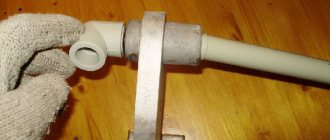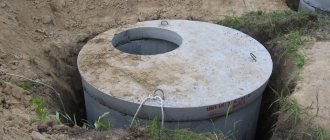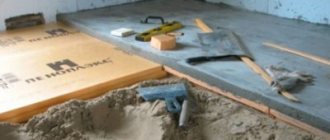The problem of water pipe freezing is relevant from the first frost until spring.
Insulated open water supply
The first to suffer are water pipes that are laid above the ground and not sufficiently insulated. In this article we will figure out how to reliably insulate a water pipe above the ground, what materials and tools are required for this.
A little about plumbing
In private construction, an open water supply system is often used to supply water from a well. It is simpler, faster and easier to assemble, and does not require the use of special equipment, for example, an excavator, etc. There is one big drawback to such a system: it is extremely sensitive to temperature changes, so it requires reliable insulation to maintain functionality. In some cases, especially when violations were made during insulation, freezing still occurs, which can lead to a pipeline rupture.
You can minimize the risk of rupture during freezing; to do this, you need to choose the material from which the pipe is made. Metal and metal-plastic pipes are most susceptible to rupture; their use is not recommended. Plastic pipe options are capable of expanding slightly under ice pressure, so their rupture when freezing occurs extremely rarely.
Water supply made of plastic pipes
Alternative methods of insulating water pipes
Sometimes craftsmen resort to other methods to ensure the system operates even in cold weather. These include insulation using high pressure. That is, freezing is excluded against the background of constant circulation of water in the system. To do this, you need to implant a receiver into the system. Pressure will be pumped into it. This method is especially good for borehole or well water supply with a submersible pump. Since it is capable of producing pressure within 5 atmospheres. But immediately after the pump, towards the pipe, you need to install a check valve.
Material selection
Questions about how to insulate a metal or plastic water pipe on the street, what materials are cheaper and what free options are available are what are primarily of interest to those who independently build or maintain their home. When choosing insulation, it is important to understand that using highly specialized materials is more convenient, but they are a little more expensive. First of all, let's look at free insulation options.
Free insulation for external water supply
One of the cheapest, and for many people completely free, insulation is sawdust. Their use allows you to minimize the cost of insulation, but complicates the process a little, because To insulate the water supply from the cold using sawdust, you will need to additionally make a box into which they are poured.
Sawdust
Manure can be used as free insulation for water pipes. During the process of rotting manure, a large amount of heat is released. It can not only protect the water supply from the cold, but also warm it up a little. As with sawdust, manure requires an additional box.
In some cases, slag is used as insulation. It is porous, contains a large amount of air and does a good job of protecting the pipeline from freezing. In private houses where individual heating boilers are installed, slag is available in sufficient quantities, so using it you can not only minimize the cost of insulation, but also save money, because Removing slag requires certain costs.
Types of insulation
If the water supply is in the ground, it should be insulated in various ways. When insulating a cold water supply, the thermal conductivity of the material is not taken into account, because it does not play a role. But they pay attention to the long service life of the insulation, its price, and strength. If there is a large difference in the temperature values of hot water and the environment, careful attention should be paid to the thermal conductivity of the insulation.
Methods that do not require special knowledge
When pipes are located at a level bordering the freezing zone, simple measures should be taken to protect the pipes from possible freezing. Actions do not require monetary or physical costs.
In the southern regions of the country, the level of laying water pipes is shallow. For them, you need to dig up a pipeline every autumn, cover it with environmentally friendly thermal insulation material on top, and then backfill it. Leaves, shavings with sawdust, and straw, which have a low level of thermal conductivity, are suitable as insulating materials. Natural material rots in the soil until the next winter, so insulation needs to be installed every year.
If calculations show that the pipeline lies slightly above the layer that protects against freezing, then there is no need to deepen the water pipes, it is necessary to raise the zero isotherm.
There are two ways:
1.increase the layer of soil on top by adding it.
2. snow that fell in winter is used as insulation.
For proper insulation, the longitudinal water line acts as the center. The width of the fill should be more than 2 times the depth of the pipeline.
Attention! Snow is considered a naturally occurring insulating material. A layer of snow equal to thirty centimeters reduces the freezing height of the soil by up to two times.
If you fill the top of the pipe with additional earth, this will affect the appearance of the area. But filling the pipes with snow, leaves, etc. will have to regularly. Specially created materials should be used as insulation. If the pipeline is laid according to rules that guarantee that the pipes will not freeze, then the area at risk should be insulated. That is, passing through a layer of rocks that freeze in winter. Thermal insulation is carried out from this area to the place where the pipe enters the room.
When introducing a pipe into a house through a cold basement, which is located lower than the freezing depth, this means that insulation only needs to be done in the basement. The pipes must be placed in special wooden boxes; the internal space must be filled with sawdust or basalt wool.
Types of materials
One of the options for insulating a pipeline is the use of shells, which are shapes that replicate the pipeline and its elements. The shell is made from different materials, it can be glass wool, polystyrene foam, basalt wool, extruded polystyrene foam, polyurethane foam, etc.
If glass wool or mineral wool is used, a foil sheath is required when laying underground. The material protects against getting wet, which reduces the quality of the material to a minimum. The foil can be replaced with a pipe winding using basalt-type roofing felt.
Attention! Cotton wool cannot be used as thermal insulation if it is not protected from moisture on the outside, because it quickly absorbs water.
It can be used to lay pipes laid in concrete trays with expanded clay covering the space inside the tray.
The shell has the shape of a finished cylinder; the inside diameter of the workpiece is equal to the cross-section of the pipe for which it is used. If the shell has a length of 60 - 2 meters, then it is a monolithic pipe that has a construction seam with an elastic material for insulation, otherwise the products have two sections. The design of several sections has advantages during installation, it is simple.
The halves in relation to the thin shell are connected by overlapping the ends of the part on top of each other to eliminate bare areas on the pipes. Meter segments are shifted up to twenty centimeters.
Attention! If it is necessary to use dense insulation, choose a shell that has a mounting chamfer along the outer edge. Products are shifted along the end side.
To fasten the shells together, use construction tape. Ensuring the protection of areas with turns and joints of discharge pipes occurs with the use of special parts.
Paint for thermal insulation, use of polyurethane foam
One of the ways to insulate an underground water supply is the use of liquid heat-insulating material. This method is easy to use in areas with non-standard pipe shapes; the thermal insulation does not form seams or cold bridges.
Polyurethane foam is produced in a liquid state; the insulation material should be applied by spraying. The paint has a high level of thermal conductivity. It has a disadvantage in the application method, because it requires special equipment.
Attention! As insulation, polyurethane foam is considered the best insulating material, but its use is characterized by complex application technology using special equipment, which is expensive. When applying, you also need to have professional skills.
To apply this type of insulation, you should invite specialists in this field. But the work has a minimum spray area; to lay a pipeline in a country house up to twenty meters long, there are hardly any people willing to do so.
A special paint is used as insulation, which is sprayed onto the pipes. It is available in cans. Using them you can insulate pipes with your own hands. Paints are produced in liquid formulations. They are applied to pipe rolls using a construction brush.
The paint contains foam glass, ceramic microspheres, and perlite. The material has low thermal conductivity. But one coat of paint will not do the job. A thick coat of paint will be expensive. This insulation method is used in areas with complex geometry and cold bridges.
If the pipeline is made of steel, then paint is applied to improve adhesion with other heat-insulating material. The paint protects the pipes from the formation of corrosion on the surface, which is what metal products in the ground are susceptible to.
Types of ready-made complex insulation materials
There are pipes that are initially thermally insulated. The products are surrounded by insulation, enclosed inside a flexible or hard shell. There are one-pipe or two-pipe methods to insulate the pipeline. For pipes supplying cold water, it is better to use a design with plastic pipes. The products have an affordable price and are easy to install.
HDPE pipes with thermal insulation are produced in the form of coils two hundred meters long. A water pipeline made of this material has a minimum of connecting sections.
If the outside of the pipe shell consists of corrugated material, then there is no need to use corner joints. The products easily create small radius bends.
How to protect insulation from external influences
To prevent the material from losing its qualities as insulation, it should be initially protected from external negative factors. Under the weight of the soil, the thermal insulation material can deform, thereby increasing thermal conductivity. For protection, a hard shell is created in the form of a pipe with a large cross-section, or in the form of a tray. Hygroscopic materials should be protected from saturation with water from the ground.
Waterproofing can be created in several ways:
1.Using aluminum foil roll as shell.
2. tape for plumbing fixtures.
3.use of roofing material.
4.Using high strength polyethylene film.
Attention! Insulation materials made of foam glass, polyurethane foam, and paint are not subject to deformation by crushing and do not absorb moisture.
To protect the insulation from mice and ants, you should wrap the insulated pipe with a fine-mesh metal mesh. Next, wrap the products in aluminum foil, or use tape, plastic pipes, or trays.
How to insulate a water pipe on the street
The construction market offers a large number of modern materials that can be used for pipeline insulation, and there are also those intended specifically for these purposes. Let's look at popular insulation materials for pipelines.
Mineral wool
One of the cheapest, but not the most practical insulation that can be used, including for plumbing, is mineral wool. The material is porous and reliably insulates the pipeline from the cold.
Rolled mineral wool
The disadvantage of this insulation is its high hygroscopicity; it strongly absorbs moisture, due to which the thermal insulation characteristics are gradually reduced.
During the operation of the pipeline, especially in conditions of insufficient ventilation, condensation constantly accumulates on its surface, which is successfully absorbed by mineral wool. It is for this reason that using it is not the best option.
There are several forms of mineral wool. Almost all are used for pipes, but it is more convenient to use one that is made in the form of a shell for water supply.
Expanded polystyrene for pipes
The next material that is successfully used to protect pipelines from freezing is polystyrene foam. It has a porous structure that contains a large amount of air, which is why it has a low thermal conductivity coefficient.
Expanded polystyrene for pipes
Expanded polystyrene does not absorb moisture well, so it can be used in places where there is direct contact with water.
Manufacturers produce polystyrene foam for pipes in the form of a shell, which is put on the pipeline and secured with a special lock or adhesive tape. It is convenient to use such insulation for a pipeline with a minimum number of turns. The fact is that polystyrene foam shells for pipes practically do not bend. For this reason, to insulate corner joints, taps and other structural elements, additional polypropylene parts are used, which are installed end-to-end with the main insulation and sealed with adhesive tape.
Foiled polystyrene foam for pipes
The material is made from ordinary polystyrene foam shell for pipes, additionally wrapped in a foil covering.
Foiled polystyrene foam for pipes
The foil reflects thermal radiation well and does not allow cold to penetrate into the material. Insulation of an open pipeline in a private house or country house using this material is more preferable, because foiled polystyrene foam more reliably insulates the pipeline from the cold.
Foamed polyethylene
Another material that is successfully used for insulating pipelines, including open ones, is foamed polyethylene.
Foamed polyethylene for pipes
It is manufactured in the form of tubes of various diameters and different wall thicknesses. For ease of installation, some types of tubular foam polyethylene have a longitudinal cut; if there is no such cut, then, if necessary, it can be easily made using a regular stationery knife.
Foamed polyethylene practically does not rot and, if installed correctly, can additionally protect the pipeline from moisture, because does not absorb water. Foamed polyethylene insulation can be installed both during pipeline assembly and after it is put into operation. Installation does not require special equipment or tools; all you need is a tape measure and a utility knife.
Advice! To reliably insulate a water pipe, you can wrap it in several layers of polyethylene foam insulation of various diameters.
Like the previous material, foamed polyethylene can be produced with additional coating in the form of foil or metallized film. Thermal insulation with a foil coating protects more reliably from the cold, but requires mandatory gluing at the joint using metallized tape. If you compare the price, then foil insulation is a little more expensive than usual.
Spraying polyurethane foam
Such insulation can reliably protect the pipeline from the cold. The disadvantage of the method is its high cost, because You will need to pay not only for the material, but also for the work of the installers. Spraying the pipeline yourself will not work. To do this, you need to have special equipment and skills to use it. It is worth considering that the foam is afraid of direct sunlight, so street water supply insulated using this method must be additionally wrapped in a material that does not allow light to pass through. We recommend roofing felt, foil or other material with similar characteristics.
Electrical low current cable
One of the options for protecting a pipeline from freezing is the use of a special heating cable. The option is expensive, because The cable itself is not cheap, and you also need to purchase a voltage regulator. Although the current consumption is not high, over a long period of operation, such a system is capable of “winding up” a decent amount.
Heating cable under thermal insulation
To install such a system, no specific skills are required; just wind the cable around the pipeline and plug it into a power outlet. The system can be combined with classic insulation; for this, after winding the wire, the pipeline is wrapped in thermal insulation. This method allows you to reduce the cost of heating the pipe and use the heating cable less often or only in emergency cases, for example, when the temperature drops below -20 or the pipeline freezes.
How to properly install a foam shell
How to insulate a water pipe with polystyrene foam? To install the shell correctly, you do not need to have any specific skills. Thermal insulation of water supply in this way can be done with your own hands in a short period of time.
The cylinder halves are put on the pipe and secured with special tape. The parts must be installed with an overlap (at least 10 cm). Also, all joints are carefully sealed with tape and a protective layer is applied to the tape.
Shaped shells are used for corner segments, nodes and turns.
Dismantling the insulation is carried out in the reverse order, removing the protective layer, adhesive tape, and then the shell itself.
Thermal insulation Energoflex
This heat-insulating material is made of foamed polyethylene. Thermal insulation for water supply pipes from the Energoflex company has a cellular structure and is ideal for thermal insulation of outdoor water pipes.
Energoflex thermal insulation guarantees high-quality insulation of outdoor water supply and is manufactured using advanced technologies using the latest equipment. The range of products offered is constantly increasing depending on customer demand.
Energoflex thermal insulation has the following characteristics:
- retains heat well. Has a low thermal conductivity coefficient;
- protects the media from overheating. Even in hot weather, the water will be cool;
- protects the pipeline that is located in the ground from freezing. Energoflex thermal insulation, even in an open area, can protect against freezing for some time in case of problems, until they are eliminated;
- protects the pipeline from condensation and corrosion. Thermal insulation Enegroflex is highly resistant to aggressive environments, therefore it can protect the water supply material from the corrosion process;
- Energoflex also has sound insulation; it effectively hides structural noise to maintain silence indoors and outdoors.
Energoflex thermal insulation is used not only as insulation for water supply pipes that are located in the ground outside, but also when installing “warm floors”, in roofing work, etc. This material has a large number of products for insulation and insulation.
These include materials in rolls, in the form of tubes and additional connecting accessories that are needed for high-quality installation of outdoor water supply insulation. Energoflex, official representative: energoflex.ru.
Self-adhesive thermal insulation for pipes Energoflex® Super SK
Alternative Methods
Protection against freezing of water supply cannot always be effectively achieved using only insulation. In severe frosts, additional protection against freezing may be required, which can be achieved using special heating cables or pressure.
Everyone knows that for every liquid there is a pressure at which it does not freeze. Thermal insulation of water pipes can also be associated with this rule. It is enough to simply embed the receiver into the pipeline.
To ensure equal pressure throughout the pipeline, a check valve is installed near the pump. Then you should close the tap installed in front of the receiver and turn on the pump.
It is optimal to create a pressure of 3 to 5 atmospheres. The main thing is that all pipeline elements can withstand such pressure. If the system can withstand such pressure, then most likely it will not freeze in winter frosts.
When it warms up, it is enough to simply normalize the pressure and the water supply can operate as usual. Protecting water pipelines using this method is possible using a submersible pump, which can create a pressure of up to 5 atmospheres.
Insulation of water pipes in the ground can be done using special electrical cables. How to insulate it using this method? The wires are laid on the water pipe longitudinally or in the form of a spiral and covered with a layer of insulation.
This method is very reliable if there is constant access to electricity. Using this method, you can heat the pipeline in one day.
Heating of underground water supply systems
To the question of how to insulate a water pipe under the floor, the answer is very simple. Most often they are wrapped in glass wool, which is secured with wire or plastic wrap.
Insulation of water pipes
This heating method is good for outdoor use, but when burying a water main with soil, it is necessary to cover the glass wool with a waterproofing layer.
Under the influence of the earth, the insulating material, the density of which is low, will gradually begin to deteriorate and the thermal insulation is impaired.
Another method of insulation is to use wire to heat the water pipes.
This method for insulating the water supply system will be more expensive, but if you install the cable yourself, you can save a lot.
Self-regulating heating cable https://elektrokhv.ru/
Such a system is turned on only in the coldest winter months and makes it possible to insulate a water pipe under the floor without burying it deeply; it is enough to dig a trench half a meter deep.
You can place the wire for heating water pipes both on the inside and on the outside, the result will be good in each case.
But if you can attach the wire for heating the water supply on the outside yourself, then for the internal location of the cable you need to call specialists.
External cable fastening is carried out in two ways: longitudinal and spiral. You need to know in advance at what distance from each other the heating wire should be located and how many turns will need to be installed for optimal operation of such a system.
You will definitely need to install thermal sensors next to the cable in order to be able to control the temperature. This method of insulation is not only the most effective, but also reliable.
Now it’s easy to understand how to insulate a pipe under the floor or underground. Using an electric wire to heat pipes installed under a layer of insulation, you can raise the temperature to the optimal value throughout the day, even in the most severe frosts.
The only disadvantage of this method is its complete dependence on the power supply, so you should not rely entirely on this option.
If there is a power outage, the water heating wire will not be able to perform its function and you should always have a backup solution to the problem on hand.
It is also recommended to install a relay when installing the cable, because some types of cable in a self-regulating state do not turn off the power and can use electricity unnecessarily.
Heating cable installation process
To install the wire you will need to perform the following manipulations:
- the pipes are dug out, the trench is expanded so that insulation work can be freely carried out;
- a heating wire is wound onto the pipe using any of the above methods;
- a layer of heat insulator (polystyrene foam or glass wool) is placed on top of the electrical cable;
- installation of a protective covering (winding with fiberglass or sheet fabric), which is secured with soft wire;
- the edges of the cable are connected to the electrical network;
- pipes are filled up.
The result is multi-layer protection, which consists of a cable, insulation, protective coating and a layer of earth.
It is worth considering that those parts of the plumbing system that are inclined do not need to be insulated at all; in such places, liquid stagnation and freezing are excluded.
Part 3. Laying a pipeline from the well to the house
And the owner of the house decides how to insulate the water supply system above ground. It is advisable to use synthetic insulation, which retains heat well and does not rot.
The correctly chosen method of insulation, using heating wire or ordinary insulation material, will save not only money, but also nerves.
You should not skimp on thermal insulation, because ruptures and replacement of damaged sections of the plumbing system will cost much more.
All insulation work must be carried out in advance during the warm season and should not be delayed until the first frost, when the first problems arise. Now you know how to insulate a water pipe on the street, and you are able to cope with this task yourself.
How to insulate a cold water pipe
Let's look at how you can insulate a cold water pipe with your own hands. Work begins with taking measurements and selecting insulation. The length of the pipe and its diameter are measured. If you plan to use roll insulation, such as mineral wool, there is no need to measure the diameter of the pipeline, since this is not important. In the case of tubular insulation, the length and diameter of the pipeline are important.
In order to properly insulate a pipe, you must follow several recommendations from craftsmen and manufacturers of thermal insulation materials:
- There should be no uninsulated areas.
- Along the entire length of the pipeline, the insulation must be securely fixed.
- The joints of thermal insulation with foil coating must be taped with metal tape.
- If the system has taps, they must be completely closed with thermal insulation material.
It is convenient to cut the insulation with a regular paper knife. Tape or plastic ties are suitable for fixing. Some manufacturers, complete with insulation, supply fasteners designed to secure it; as a rule, these are plastic clips. The installation step of the fastening clips should not exceed 15 cm.
Clips for pipe insulation
If for reliable insulation it is necessary to make a frame (box), it can be made from boards. The wooden structure is rigid and does not require additional protection from mechanical damage. You can also make a box from foam plastic; it is less durable, but additionally protects the pipeline from freezing. To fasten sheets of foam plastic to each other, it is convenient to use polyurethane foam; in addition, it will save the structure from the penetration of cold, because will fill the gaps between frame elements.
Heating of water supply with cable
You can insulate an outdoor water pipe using a special cable. Using this method has several advantages:
- there is no need to lay pipes below the freezing level;
- You can adjust the heating and turn it on or off as needed.
Available in two types: for installation inside the pipe and for installation outside. Thus, the pipeline will be protected even in the most severe frosts.
However, when using it, energy consumption increases, so it would not be rational to keep it on all the time. It is better to connect the heating electric cable in severe frost or at night, when no one uses water and there is a risk of defrosting the system.
Is it necessary to insulate a sewer pipe?
Owners of private houses often ask questions about insulating sewer pipes. Is this as necessary as the manufacturers of thermal insulation materials advise? The fact is that a properly installed sewer system, which has a normal drainage angle and pipe diameter, can function in winter without additional thermal insulation. But who can guarantee that your system is perfectly designed and assembled, so it’s better to play it safe and equip it with additional protection with thermal insulation materials.
Additional frost protection pressure and cable
Another effective method of thermal insulation is insulating the water supply by heating the pipe with a cable. The essence of this approach is that a heating cable is attached to the outside of the pipe along its entire length. The top is wrapped with the usual layer of insulation, which were described earlier.
This approach is applicable in dachas and homesteads, where there is no constant flow of water, and the pipes can thaw only by the beginning of autumn. When using cable heating, you can speed up the defrosting process or prevent it altogether.
How to insulate pipes with cable? It is wrapped around the pipe in increments of 10-20 cm. The heating power should be in the range of 10-12 W/m (Watts per meter). To reduce energy consumption when heating, you can use temperature sensors located in several places throughout the entire distance where insulated water pipes pass. When the temperature drops below +5 degrees, the control system notifies the owner by SMS message or email. You can also set the heating to turn on automatically when this temperature is reached.
Another interesting method of protecting communications from freezing in winter has the right to life - pressurized water. You may know that water under pressure does not freeze. And if you create a pressure of 3-5 atmospheres in the water supply throughout the entire area, before entering the house, it will not freeze in winter. This method is suitable for dachas or country houses that are not used in winter. As it gets warmer, you can open the tap and let the water out so that the pressure equalizes.
To implement this technique, you need to have a receiver (expansion tank), a pump and a check valve after the pump.
We close the tap in front of the receiver, the pump pumps up the pressure in the system to 3-5 atmospheres, after which you can leave the system for the winter, after making sure that the pressure remains constant.
How to insulate sewer pipes in a private house
The sewer system is insulated according to the same principle as ordinary water supply. All drain insulation work is carried out at the sewer assembly stage, because in most cases the system is closed and located in the ground.
Insulated sewer system
The materials you can use are roll insulation or special heat insulators for large diameter pipelines. Foil-coated materials are preferable, because they are able to protect the pipeline from direct contact with moisture, which will have a positive effect on the service life of the drain. This is especially true for metal drain structures, because... they are more sensitive to the effects of aggressive substances.
In conclusion of the article, we note that you can insulate a water supply pipe located on the street or in an unheated room yourself; there is nothing difficult in the work. The main thing is to follow the recommendations and use the right material.
Requirements for materials used
Materials used for insulation of water supply pipes must have the following characteristics:
- Low thermal conductivity and the highest possible heat retention capabilities;
- Completely resistant to moisture;
- Good resistance to aggressive external factors;
- Long service life;
- Easy installation;
- Low cost.
Compliance with all the described qualities allows us to say that the selected material is good enough for pipe insulation. However, there are no ideal insulation materials, so you need to choose depending on the specific operating conditions.











